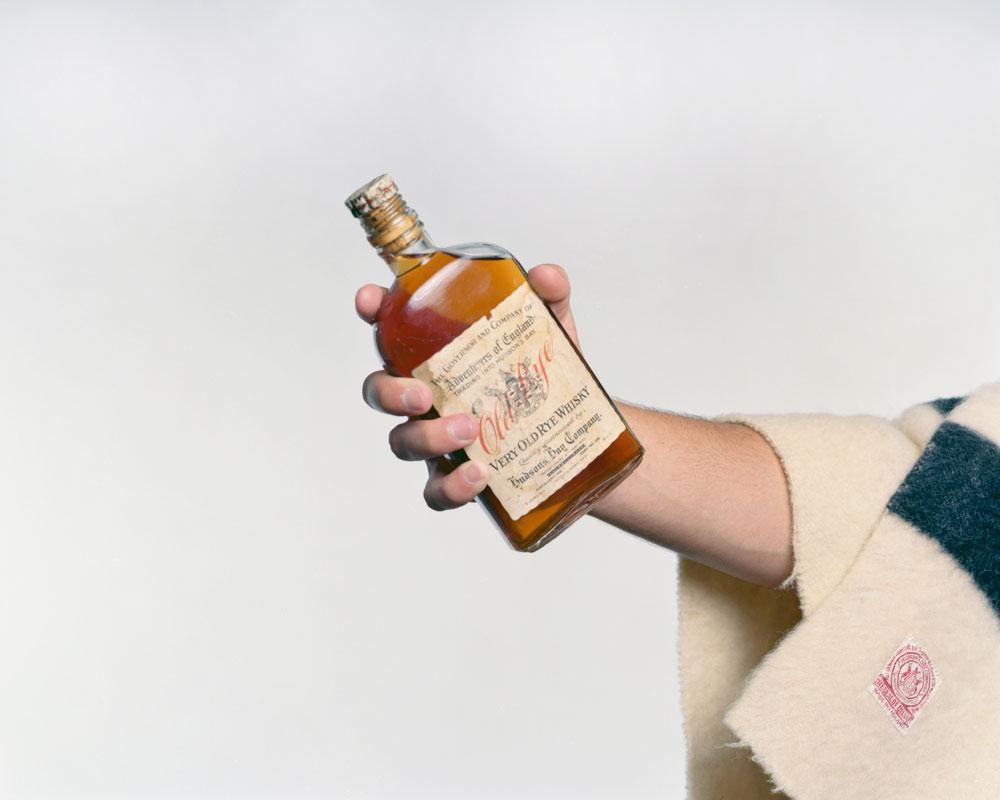“Trade Marks,” curated by Betty Julian at Prefix Institute of Contemporary Art, contributes to dialogues on Aboriginal art also being explored in Toronto this fall via the ImagineNative festival (of which the exhibition is a part), “Ghost Dance” at the Ryerson Image Centre, and Brian Jungen and Duane Linklater’s film Modest Livelihood at the Art Gallery of Ontario. “Trade Marks” invites viewers to consider a number of interconnected themes: deeply rooted economies of exchange in phenomena such as the fur trade; legacies of other forms of autonomous Aboriginal labour; advocacy for indigenous space; acknowledgement of rights to land and resources; bearing witness to and memorializing Aboriginal trauma; and celebrating the enduring strength of community.
The centrepiece of the exhibition is provided in two works by Keesic Douglas—Trade Me (2010), a two-part photographic and film work, and Traded (2013), a more recent set of photos. Both wryly examine the history and impact of the iconic Hudson’s Bay Company blanket—and the company’s wider activities—on indigenous communities.
In one image from Trade Me, a figure cloaked in the familiar Bay textile holds out a whiskey bottle, evoking the introduction of alcohol that accompanied activities of the company, as well as pointing to the legacy of this action. In another image, a lone rifle is propped against a tree. For me, the gun conjured a devious colonial-trader practice—that is, gradually lengthening gun barrels in order to obtain more furs per trade (the market value of such weapons was deemed equal to their height in stacked furs).
The most provocative, and perhaps productive, of Douglas’s statements is delivered by way of the filmic portion of Trade Me. In it, we travel with the artist on a canoe expedition to return his ancestors’ Bay blanket to the company’s flagship store in downtown Toronto. Douglas and a collaborator paddle and camp their way from Rama First Nation towards the city, ultimately abandoning their waterlogged canoe in the Humber River before riding a streetcar towards Yonge and Queen, blanket in tow. (When I attempted to map their journey after seeing the show, I was simultaneously perplexed by their route and in awe of the intricate passages they followed.)
Once the Trade Me narrative enters the Bay store, Douglas stuns a manager by explaining he’s come to return the blanket in exchange for his families’ furs. After being told the store is “no longer in the fur-trading business,” the artist asks the manager if he and his companions might perform an honour song. While moving out of frame, the manager, in an attempt at levity, invites the men to “entertain us.” His phrase is so brief and flippant it’s easy to miss, but it is important. First, the premise that a public display of Aboriginality might be reduced to pure entertainment is difficult to swallow. Second, his use of “us” is telling—the term is inclusive, and in the context of the exhibition, it implicates viewers and invites them to consider their position in relation to Douglas and, by extension, to the three other artists on view.
The way Douglas’s work challenges viewer perceptions of self and other is in step with the other works in the show. Nigit’stil Norbert leaves painted markings in gritty urban alleys of a stencil derived from her grandmother’s needlework. This action ties a familial narrative to one of larger issues of indigenous displacement. Meryl McMaster has cut pages from North American history books and positioned them in a whirl around her in her Murmur self-portraits, inviting us to consider the roles of language and writing in the formation of colonial identity. Lastly, multimedia artist Bear Witness’s commissioned audio work re-indigenize(everyone) (2013) layers and re-edits familiar material such as Wednesday Addams’s Thanksgiving monologue from Addams Family Values with drumming, words, rhymes and hip hop, delivering a satisfying and energetic corporeal pulse.
The term “mark” is slippery and mutable, implying a lingering indicator, a scar. But it also evokes the action of gesture and writing, suggesting the agency required to “make one’s mark.” For me, considering each of the works on view evoked the place and agency of Aboriginal communities as they have sought—and continue to seek—an equal and respectful ground for dialogue and exchange.
I was also reminded, in reviewing this exhibition, of Vancouver scholar Paige Raibmon’s writings on the complexity of Aboriginal-settler cultural relations. As Raibmon suggests in her book Authentic Indians, “Whites imagined what the authentic Indian was, and Aboriginal people engaged and shaped those imaginings in return. They were collaborators—albeit unequally—in authenticity. Non-Aboriginal people employed definitions of Indian culture that limited Aboriginal claims to resources, land, and sovereignty, at the same time as Aboriginal people utilized those same definitions to access the social, political, and economic means necessary for survival under colonialism”.
My feeling is that the four emerging artists presented in “Trade Marks” have staked a claim amongst the complex, diverse and potentially contradictory indigenous-settler encounters found within Canadian histories, all the while inviting participation, collaboration and exchange.









